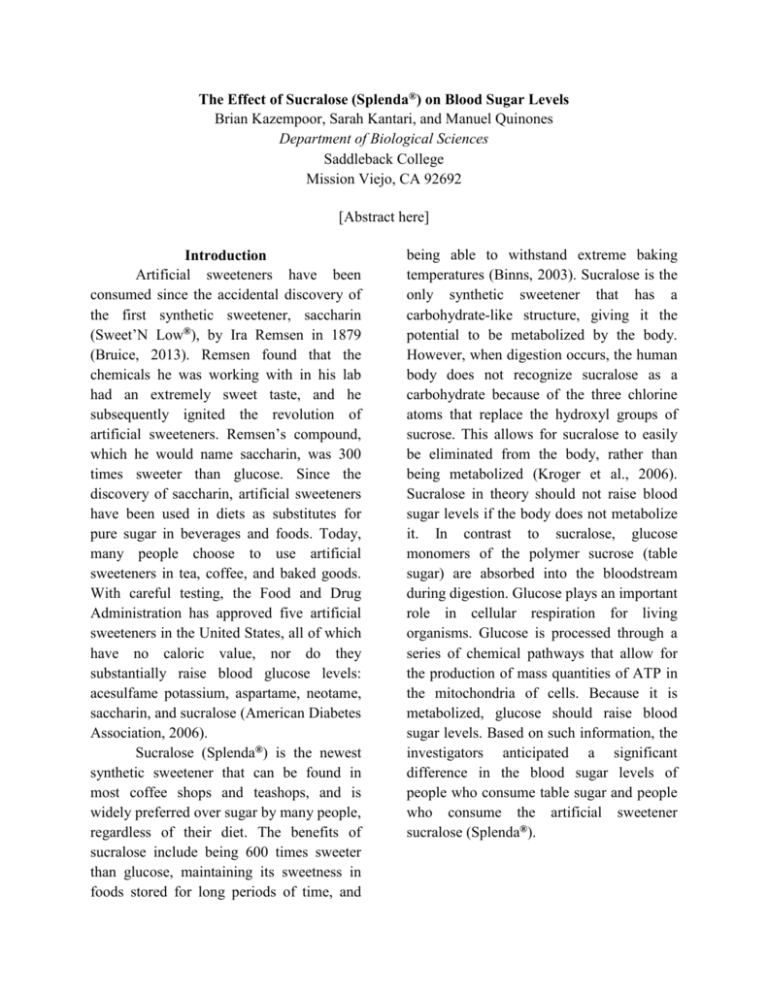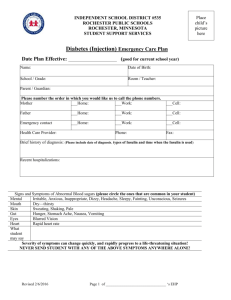
The Effect of Sucralose (Splenda®) on Blood Sugar Levels
Brian Kazempoor, Sarah Kantari, and Manuel Quinones
Department of Biological Sciences
Saddleback College
Mission Viejo, CA 92692
[Abstract here]
Introduction
Artificial sweeteners have been
consumed since the accidental discovery of
the first synthetic sweetener, saccharin
(Sweet’N Low®), by Ira Remsen in 1879
(Bruice, 2013). Remsen found that the
chemicals he was working with in his lab
had an extremely sweet taste, and he
subsequently ignited the revolution of
artificial sweeteners. Remsen’s compound,
which he would name saccharin, was 300
times sweeter than glucose. Since the
discovery of saccharin, artificial sweeteners
have been used in diets as substitutes for
pure sugar in beverages and foods. Today,
many people choose to use artificial
sweeteners in tea, coffee, and baked goods.
With careful testing, the Food and Drug
Administration has approved five artificial
sweeteners in the United States, all of which
have no caloric value, nor do they
substantially raise blood glucose levels:
acesulfame potassium, aspartame, neotame,
saccharin, and sucralose (American Diabetes
Association, 2006).
Sucralose (Splenda®) is the newest
synthetic sweetener that can be found in
most coffee shops and teashops, and is
widely preferred over sugar by many people,
regardless of their diet. The benefits of
sucralose include being 600 times sweeter
than glucose, maintaining its sweetness in
foods stored for long periods of time, and
being able to withstand extreme baking
temperatures (Binns, 2003). Sucralose is the
only synthetic sweetener that has a
carbohydrate-like structure, giving it the
potential to be metabolized by the body.
However, when digestion occurs, the human
body does not recognize sucralose as a
carbohydrate because of the three chlorine
atoms that replace the hydroxyl groups of
sucrose. This allows for sucralose to easily
be eliminated from the body, rather than
being metabolized (Kroger et al., 2006).
Sucralose in theory should not raise blood
sugar levels if the body does not metabolize
it. In contrast to sucralose, glucose
monomers of the polymer sucrose (table
sugar) are absorbed into the bloodstream
during digestion. Glucose plays an important
role in cellular respiration for living
organisms. Glucose is processed through a
series of chemical pathways that allow for
the production of mass quantities of ATP in
the mitochondria of cells. Because it is
metabolized, glucose should raise blood
sugar levels. Based on such information, the
investigators anticipated a significant
difference in the blood sugar levels of
people who consume table sugar and people
who consume the artificial sweetener
sucralose (Splenda®).
Materials and Methods
A TRUETrack® Blood Glucose
Monitoring System was purchased from
Walgreens
(Mission
Viejo,
CA).
Sterilization supplies, which include alcohol
and cotton balls, and additional glucose
strips were also purchased at Walgreens
(Mission Viejo, CA). Arrowhead® distilled
water, table sugar (C&H® pure sugar), and
sucralose sweetener (Splenda®) were
purchased from Albertsons (Mission Viejo,
CA). The sharp box used to dispose of
needles was obtained from one of the
investigators’s employer, Ross Medical
Associates (San Juan Capistrano, CA).
Data collection took place in April
2014 on the Saddleback College campus.
The experimenters requested ten healthy (no
prior history of blood sugar related health
problems) Saddleback College students to
volunteer in the experiment. After written
consent from each volunteer was obtained,
the subjects were asked to fast for 8 hours
prior to each testing and data collection day.
On the first day, the subjects’ blood glucose
levels were tested before the consumption of
unsweetened water. The subjects were then
asked to drink distilled water with no
sweetener. After 45 minutes, blood glucose
levels were tested again. On the second day,
the subjects’ blood glucose levels were
tested before the consumption of table
sugar-sweetened water. The subjects were
then asked to drink the water with table
sugar. After 45 minutes, blood glucose
levels were tested again. On the third and
final day, the subjects’ blood glucose levels
were tested before the consumption of
sucralose-sweetened water. The subjects
were then asked to drink the water with
sucralose sweetener. After 45 minutes,
blood glucose levels were tested again. The
sweetened waters contained 1 packet of
sucralose or table sugar per 237 mL (1 cup),
with the exact concentration being 4.219
grams of sweetener per liter. The 45-minute
gap between consumption of the water and
blood sugar testing allowed for the water to
be digested. Blood glucose levels were
tested using the TRUETrack® Blood
Glucose Monitoring System. To analyze
data, the experimenters conducted an
Analysis of Variance (ANOVA) using
Microsoft Excel. An analysis of variance
was used to test for a significant difference
in blood glucose levels with the
unsweetened, sucralose sweetened, and table
sugar sweetened waters. Using QuickCalcs
on GraphPad Software, a Bonferroni posthoc test was run to test for a significant
difference in the data between two specific
groups.
Results
Investigators tested the difference in
blood glucose levels from fasting prior to
consuming the water, and 45 minutes after
consuming the water. Preliminary testing
showed that the 45-minute mark after
consumption was the average peak time in
blood glucose levels. The mean difference in
blood glucose levels with unsweetened
water was 4.10 mg/dL (milligrams per
deciliter) ± 0.66 mg/dL (±SE), N=10. The
mean difference in blood glucose levels with
table sugar-sweetened water was 14.10
mg/dL ± 1.37 mg/dL (±SE), N=10. The
mean difference in blood glucose levels with
sucralose-sweetened water was 4.40 mg/dL
± 0.58 mg/dL (±SE), N=10. Figure 1
represents the mean difference in blood
Mean Difference in Blood
Glucose Levels
glucose levels with the consumption of the
three types of waters. After conducting a
single factor ANOVA, a p-value of 2.0*10-8
was obtained. Because p<0.05 (95%
confidence interval), a Bonferroni post-hoc
test was run to test for a significant
difference in the average difference in blood
glucose levels when consuming table sugar
and when consuming sucralose. The
multiple comparison adjustment showed a
statistical difference in blood glucose levels
with table sugar-sweetened water and
sucralose-sweetened water (Difference in
means = 9.70 mg/dL, 95% confidence of
difference = 6.30 mg/dL-13.10 mg/dL)
18
16
14
12
10
8
6
4
2
0
Water
Water with Water with
Table Sugar Sucralose
Beverage
Figure 1. Average difference in blood glucose levels
(milligrams/deciliter) 45 minutes after consumption
of beverage. Mean difference in blood glucose levels
with unsweetened water was 4.10 mg/dL (milligrams
per deciliter) ± 0.66 mg/dL (±SE), N=10. Mean
difference in blood glucose levels with table sugarsweetened water was 14.10 mg/dL ± 1.37 mg/dL
(±SE), N=10. Mean difference in blood glucose
levels with sucralose-sweetened water was 4.40
mg/dL ± 0.58 mg/dL (±SE), N=10. There is a
significant statistical difference in blood glucose
levels with consumption of table sugar and
consumption of sucralose (p=2.00*10-8, single factor
ANOVA, Bonferroni Correction). Error bars are
Mean ± SEM.
Discussion
The results convey a significant
difference in the change in blood glucose
levels when consuming sucrose (table
sugar), and when consuming sucralose
(Splenda®). The change in blood glucose
levels with sucralose-sweetened water very
closely resembled the change in blood
glucose levels with unsweetened water.
However, most blood glucose levels
understandably
decreased
with
the
consumption of unsweetened water; for
statistical purposes, the absolute value of
these differences in blood glucose levels
were taken. With sucralose-sweetened
water, blood glucose levels only increased at
an average of 4.4 mg/dl, which is
significantly less than the mean increase in
table sugar-sweetened water, 14.1 mg/dl.
This mere partial increase in blood glucose
levels after the consumption of sucralose is
observed because the body digests and
converts only a very small percentage of
sucralose into glucose monomers. As shown
below in Figure 2, sucrose and sucralose are
very similar in chemical structure. For
sucralose to be broken down into glucose
monomers, the chlorine substituents must be
removed. This would allow some of the
sucralose to be digested as sucrose.
Figure 2. Chemical structure of sucrose and
sucralose
Nino Binns of McNeil Nutritionals,
LLC explains that on average, 15% of a
dose of sucralose is absorbed and then
rapidly excreted, with most of it remaining
unchanged through urine (53). Of the 15%
that is absorbed by the body, 2% of the
ingested sucralose is removed through the
urine in the form of glucuronide conjugates,
inactive glycosides used by plants to store
chemicals. Although ADME (absorption,
distribution, metabolism, and excretion)
studies have found sucralose to be poorly
digested and mostly removed through feces,
the slight increase in blood glucose levels
with the consumption of sucralose cannot be
overlooked. The notion that sucralose does
slightly raise blood glucose levels provokes
the question whether there is a form of
chemical dechlorination occurring within the
sucralose disaccharides. The possible
chemical reaction that would occur at the
atomic level would have to involve the
substitution of the chloride substituents with
hydroxyl groups, either by the SN1 or SN2
mechanism.
Because scientific studies claim
sucralose does not hydrolyze or undergo
dechlorination in any manner after ingestion,
we must look to other sources to explain the
increase in blood glucose levels with
sucralose. It is possible to suggest that
Splenda® artificial sweetener contains a
small amount of sucrose that is not
chlorinated during production of the
product. However, the very small portion of
unchlorinated sucrose should not have an
effect on blood glucose levels as large as
observed during the course of this
experiment.
Nevertheless,
consuming
sucralose is a much healthier and smarter
choice than consuming regular table sugar,
mainly because of the mitigated increase in
blood sugar levels. Sucralose is safe to use
in large amounts in foods, as the chlorine in
the sweetener is not toxic. Also, sucralose is
unaffected by the polarity of ethanol, which
makes it a good sugar substitute for high
calorie alcohols. And, from a dental
standpoint, oral bacteria enzymes cannot
break down sucralose, meaning that tooth
decay is prevented.
Sucralose is a great choice for many
people, as it is a sweet substitute to reduce
caloric intake.
Sucralose also assists
diabetic people in coping with a lifestyle
with limited sugar. Everyone should
consider the long-term benefits of putting
down the regular sugar and switching over
to Splenda®.
Acknowledgements
We would like to thank Professor
Steve Teh for his guidance and assistance
throughout the project. We would also like
to thank Dr. William Alston of the
Chemistry Department for the knowledge he
provided us with, and Saddleback College
for the use of its facilities and equipment.
Lastly, we thank our fellow students for
their time and help with this project.
Literature Cited
American Diabetes Association (2006).
Nutrition Recommendations and
Interventions for Diabetes-2006.
Diabetes Care. 29(9) 2140-2157.
Binns, N. M. (2003). Sucralose – All
Sweetness and Light. Nutrition
Bulletin. 28, 53–58.
Bruice, P. Y. (2013). Organic Chemistry.
Upper
Saddle
River,
NJ:
Pearson/Prentice Hall. 7, 1047.
Kroger, M., Meister, K. and R. Kava (2006).
Low-calorie Sweeteners and Other
Sugar Substitutes: A Review of the
Safety
Issues.
Comprehensive
Reviews in Food Science and Food
Safety, 5: 35-47.
Renwick, A.G., and S. Molinary (2010).
Sweet Taste Receptors, Low-energy
Sweeteners, Glucose Absorption and
Insulin Release. British Journal of
Nutrition. 104. 1415-1420.








